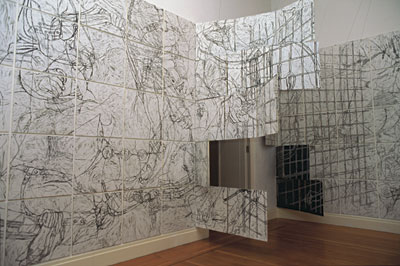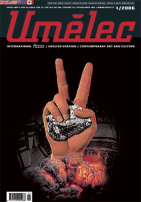| Revista Umělec 2006/1 >> Documentarism Between Reality and Fiction | Lista de todas las ediciones | ||||||||||||
|
|||||||||||||
Documentarism Between Reality and FictionRevista Umělec 2006/101.01.2006 Eva Scharrer | dokumentarismus | en cs |
|||||||||||||
|
Video projections in documentary format, sociological case studies and archival work have been bringing more people into museums since big exhibits like documenta X and numerous biennials. In recent years “Documentary Turn”1 has itself become a subject in contemporary art for closer curatorial examination. This has been made very clear by exhibits such as (Based Upon) True Stories at the Witte de With contemporary art center in Rotterdam (2002) or Experiments with Truth at the Fabric Workshop and Museum in Philadelphia (2004). But by the time of documenta XI and the last Berlin Biennale, the public and many critics had grown weary of documentaries.2
A rather conservative art public finds fault with documentary films that are an hour or more in length, considering them “unreceivable” in an exhibition context, and the question persists regarding the artistic value of documentaries with socially critical and political content. Despite such criticism, and a good deal of proclaiming the genre dead,3 the need for contemporary art to return to documentary methods and content remains undiminished; this is definitely related to the radical social and political changes in Europe after 1989, and far-reaching global events such as 9/ll and their consequences. In Switzerland alone, three concurrent exhibits in Lucerne, Muttenz and Nyon are examining the aspects of practical experience in documentary art from various points of view. All three exhibits show that the subject need not be “out,” boring or didactic. With such varied approaches the diversity of media with which the broad theme of “documentation” is tackled is striking. It is not explicitly a matter of pure black box presentations with time-consuming video documentations, which Hito Steyerl aptly describes as “...dark aisles of documentary cathedrals in which the bright light of the world seems to shine in through digital glass windows.”4 These occur naturally as far as theme goes, and in fact the documentary approach is attempted in photography, painting, sculpture and installation. It’s primarly about, and not only in the video medium, aesthetic shifts and diffusions of format itself,5 about specific questionings of the method of presenting. The word itself, documentary,6 is derived from a legal term concerned with objectivity, the truth and the highest degree of authenticity possible. At the same time this requirement is anything but fulfilled in that which goes around in the media under the guise of “docu” and, not just in the age of reality TV, docu-fiction and Infotainment. Ever since the advent of photography, media images have been manipulable and contextually distorted. Artists today learn documentary methods so they are well aware of how they are assembled. Various strategies exist to make these methods of assembly clear, to undermine them or to acquire them subversively. They range from self-reflective documentation of the work processes on different participatory methods up to infiltration and blending of documentary with moments of subjectivity, poetry, irony or fiction. The exhibition project The Need To Document, a cooperation between Kunsthaus Baselland, Muttenz, Halle für Kunst e.V., Lüneburg and the art initiative tranzit, Prague, places its thematic focus on the countries of Eastern Europe in transition. The impression of political change in recent years is just as present in the works as a relaxed approach to history and national identity, which the presentation of social reality closely ties with the reflection of its particular method of working. Artists such as Mircea Cantor virtually enter the documentary field through the back door: the video Double-Headed Matches appears only at first glance to be an instructional film on match production in a Romanian factory. By the time the matches are given a second head one has guessed that this involves not merely a study of post-communist work conditions, but an art project. The project itself, like the documentation of the creation, is of a subtle and ambiguous absurdity. This stands out as well in the Polish art group Azorro’s film Everything Has Been Done, a self-ironic reflection on the requirements for making art where the production and reality of futile endeavors to conceive something new collide. Zbyněk Baladrán also addresses the particular artistic experience and thereby simultaneously touches on the theme of state censorship, in which he comments on his work process with documents from socialist film archives - he himself speaks of “non-intervening archaeology” - with obviously self-censored written fragments. The collaboration Big Hope follows another strategy and relinquishes the act of documenting itself to the subject of its sociographic investigation through the use of a disposable camera. For the project Re:route (2002) they asked immigrants in Turin to photograph and comment on places of personal significance. The collected personal testimonials of individual experiences of the town sketch such a three-dimensional mental map of Turin that its navigation opens up a completely different view of the city than that of a local resident or a tourist. Methods of participation, sale, video workshops or service (as far as giving up authorship in favor of open social structures) are possible ways of approaching a resolute reality in the media. Comparable strategies one finds, for example, in the works of Stephen Willats or Nasrin Tabatabai.7 From time to time the artistic works, above all in the conceptual decision, involve exhibiting found film material or film produced under someone else‘s direction in artistic context. In this connection also noteworthy is the work of American-Palestinian artist Emily Jacir, who with her privilege of possessing two passports and therefore unrestricted freedom of movement takes up the cause of the people of Palestine, for whom unhindered travel is not possible. Where We Come From (2001-2003) is based on the simple question, “What can I do for you in Palestine, where can you not go, where I however can?” The work involves the documentation of the realization of extremely varied, part banal-pragmatic, part symbolic or intimate-personal actions. Or else, all the more urgent, in the documentation of failure by managing a simpler way. “...to counter the official reporting.” Willie Doherty’s request formulates the lowest common denominator of artistic documentation. On January 30, 1972, 13 unarmed civilians were shot by British troops in Doherty’s hometown of Derry in Northern Ireland; the day went down in history as “Bloody Sunday.” The installation of the same name exhibited in Nyon projects a press photo of people demonstrating and a then a shot of the same spot, empty; this confronts with archival records and memories of people who watched the trauma of that day as eyewitnesses or on television. The documentation here doesn’t turn out to be a taking of evidence from the facts, but serves rather as a filter of collective memory. Reprocessing Reality examines the relationship of documentary film and art and thus trains its sights on a reality, that is depicted, multiplied, manipulated and distorted, until it questions itself. What message do images convey? What do they reveal about the view of those documented and those observing? Taryn Simons produces photographs based on false identification of people mistakenly sentenced to life imprisonment at potential scenes of the crime and the Atlas Group’s fictitious photo archives of the Lebanese Civil War (1975-91) examine the suggestive strength of images and at the same time their dubious nature as a document. Omer Fast’s complex, linguistically-versed video works take on a TV format as docu-features. Through operations dissecting the material, Fast subtly explores the limits of the tangled game of reality and fiction, and experienced history juxtaposed with fabricated production. In his work Spielberg’s List, for example, he interviews extras from Steven Spielberg’s film Schindler’s List at the original locations in and around Krakow, where the levels of time and space – the “historical” level of the Third Reich, the “fictional” level of the film and the “real” of the present – are shifted more and more and superimposed to the point it is impossible to distinguish them. Something similar occurs in the Godville installation about an actor in a living history museum in Virginia. The ambivalence of the fabricated and authentic roles of the “inhabitant” is diffused by Fast even further by montages and spoken word sampling. In contrast to that, Christoph Büchel “fictionalizes” reality, exhibiting the brutal truth. It takes awhile to realize that you are not in front of a computer game but that the little white dots on the screen—men running for their lives—are targets for an American AC-130 bomber in Afghanistan. The images comes from the Internet. Despite the incomprehensibility of what is seen, it is difficult to avoid the vortex of the supposed “game” – to aim and fire at the dots. The transfer of reality without comment to the museum context should not so much sharpen our sensibility to that which is actually shown, but rather our interaction with the images through which reality is presented to us. “The museum is not the place to lament the sad fate of unfortunate people, but a context where we can contemplate the reason why something moves us, why something makes us question, or leaves us utterly cold.”8 The documentary function of art can also consist of undermining representational forms through deliberate deconstruction of its own methods. With their varied approaches, from the supposedly naive “need to document” to the cynical unmasked recycling of media reality, all three exhibitions offer multi-layered reflections on the meaning and shift of meaning of the documentary production of images. Notes: 1. See Mark Nash (Ed.), Experiments with Truth, Fabric Workshop and Museum, Philadelphia, essay by Okwui Enwezor and the editor. 2. See e.g. the press review from Berlin Biennale 3, curated by Ute-Meta Bauer. The reviews were to a large extent negative, attributes such as “didactic” or “boring” appear frequently. On the other hand, the reproach is frequently heard from “professional”documentary film makers that artisitc documentation would be comparable to journalistic creations of the film industry which realised on a completely different budget would be of poor quality. 3. See e.g. Joerg Hentschel, „No Risk. No Fun. Art in NY.“, in Sueddeutsche Zeitung No. 62, Monday, March 15, 2004, p. 15. 4. Hito Steyerl, „Politics of the Truth. Documentary in the Field of Art.“ in The Need to Document exhibition catalog Kunsthaus Baselland and Halle fuer Kunst Lueneberg, JRP Ringier Zurich, 2005. 5. See for this Soren Grammel, Work Surface Video, ibid. 6. Hito Steyerl as well as others refer to the fact that the question what “documentarism”really is for a long time theoretically has not been settled, ibid. 7. See Soren Grammel, Work Surface Video, ibid. 8. Claudia Spinelli (Ed.), „Reprocessing Reality“ exhibition catalog, JRP Ringier Zurich, 2005, with reference to Susan Sontag, „Das Leiden anderer betrachten“ (Regarding the Pain of Others), Munich 2003.
01.01.2006
Artículos recomendados
|
|||||||||||||














Comentarios
Actualmente no hay comentariosAgregar nuevo comentario